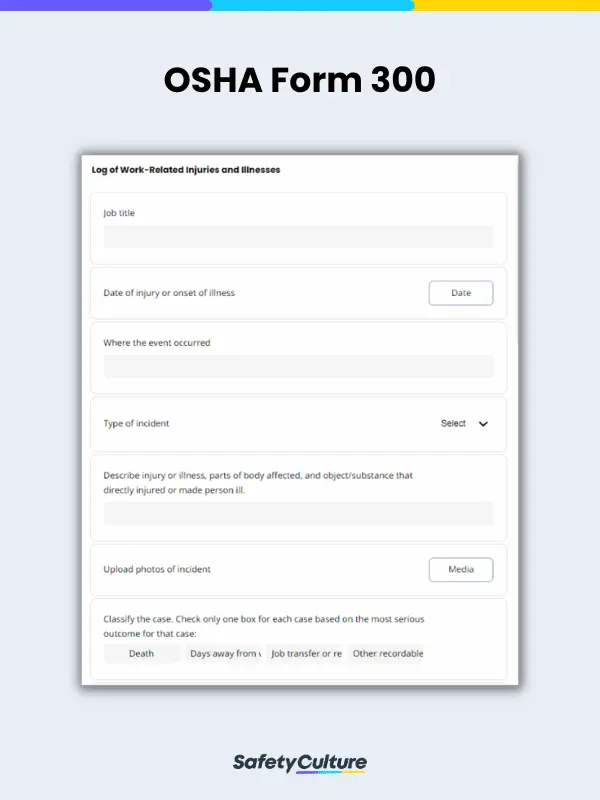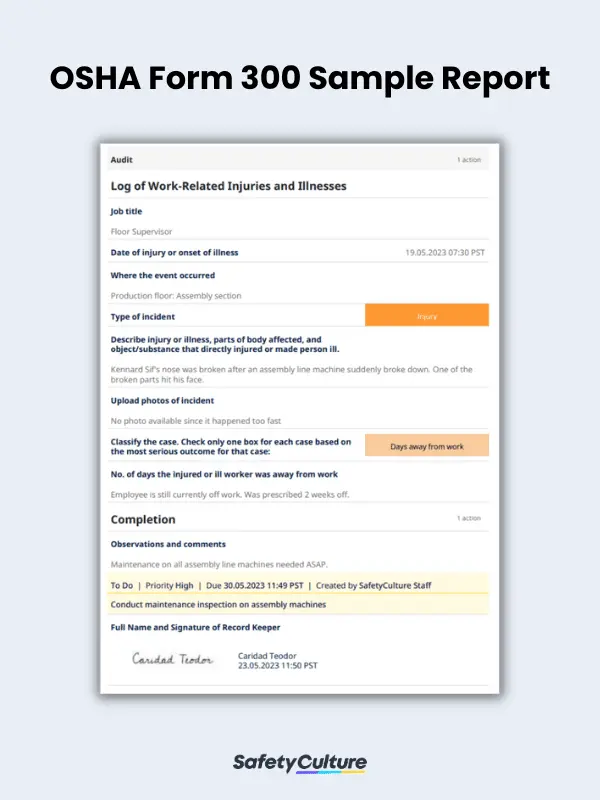What is an OSHA Form 300?
An OSHA Form 300, also known as he “Log of Work-Related Injuries and Illnesses,” is used to document work-related injuries and illnesses and how they happened. Created by the US Occupational Safety and Health Administration (OSHA), this form aims to record all workplace safety concerns in order to better address them in the future.
Purpose
The OSHA Form 300 is a document utilized by employers to accurately record and track work-related injuries and illnesses within their organizations as they happen. Its primary purpose is to promote workplace safety as it can help employers and safety officials better track and analyze workplace risks and their effects. By maintaining this log, employers can thus identify areas of improvement in their safety protocols, implement corrective actions, and ultimately foster a safer work environment for their employees.
Additionally, OSHA utilizes the information recorded on Form 300 to identify high-risk industries, allocate inspection resources, and develop targeted strategies to enhance occupational health and safety. It serves as a comprehensive log that records relevant information about each incident, including the nature of the injury or illness, the affected employee, the date of occurrence, and the circumstances surrounding the event. This form facilitates a systematic approach to injury and illness record-keeping, enabling employers to evaluate workplace safety, identify patterns, and implement preventive measures.
What to Include in an OSHA Form 300 Document
The OSHA Form 300 can be downloaded from OSHA’s website. However, as OSHA also accepts equivalent documents, you also have the option to create your own as long as your copy will have the same details.
Following OSHA standards, your OSHA Form 300 should thus contain fields for this information:
- Case number per incident
- Employee’s name and job title
- Date of injury or illness onset
- Location of where the event occurred
- Description of the injury or illness, body parts affected, and the cause of injury or illness
- Type of illness or injury
- Classification of the case and the health status of the employee
- Number of days the employee was sick or injured for
How to Fill Out the OSHA Form 300
The OSHA Form 300 should ideally be filled out in the order of which question or field comes up first. Typically, it is filled out in the following order:
- Write down the case number, the injured or ill employee’s name and job title, and the name of the person preparing the report.
- Detail the event that caused the injury or illness along with the time it happened, the location, the affected body parts, and the kind of injury or illness sustained.
- Classify the case accordingly into whether or not the employee died, was transferred to a different department, or took a leave of absence.
- List down the effects of the event, such as the current working status of the employee, their health condition, and, if applicable, the number of days they took off from work.
- Provide additional observations and comments that may be important to the report as necessary.
Here is a sample OSHA Form 300 filled out for reference:
FAQs about the OSHA Form 300
The OSHA Form 300 is used to record and log each injury and illness that happens due to work-related factors. On the other hand, the OSHA Form 300A provides an overview of the total number of cases of injuries and illnesses, days away from work, and types of injuries or illnesses that happened in a given timeframe.
Employers must save the OSHA Form 300 and the OSHA Form 300A and OSHA Form 301 for five years. Additionally, the filled-out OSHA 300 Forms should be updated regularly to include any newly discovered recordable injuries or illnesses.
OSHA law requires employers with ten or more full-time employees to keep a copy of OSHA Form 300 for injuries and illnesses. Employers with less than ten employees are not required to follow this but are strongly encouraged to.




